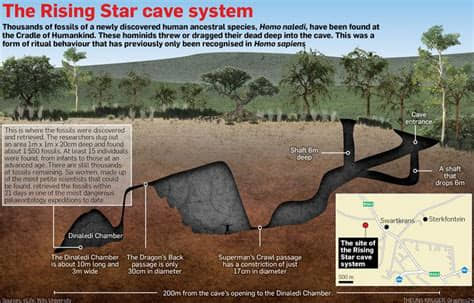241,000 to 335,000 Years Old Rock Engravings Made by Homo naledi in the Rising Star Cave system, South Africa

Abstract
The production of painted, etched or engraved designs on cave walls or other surfaces is recognized as a major cognitive step in human evolution. Such intentional designs, which are widely interpreted as signifying, recording, and transmitting information in a durable manner were once considered exclusive to Late Pleistocene Homo sapiens. Recent work has demonstrated that other hominin groups also made such marks, including Neanderthals (Rodríguez-Vidal et al., 2014; Hoffmann et al., 2018), and possibly Middle-Pleistocene Homo erectus (Joordens et al., 2015). Such durable signs indicate an intentionality characteristic of meaning-making (Kissel and Fuentes 2018) which has been argued to require significant levels of cognitive abilities not found in species with smaller brain sizes (Parkington, 2010). In fact, the evolution of such meaning-making symbols is thought to be a core aspect of what it means to be “human” (Henshilwood, 2009). Here we present the first known example of abstract patterns and shapes engraved within the Dinaledi subsystem of the Rising Star Cave in South Africa. We identified markings incised into the dolomitic limestone walls of the cave. The engravings described here are deeply impressed cross-hatchings and other geometric shapes. The surfaces bearing these engravings appear to have been prepared and smoothed. In some areas there is residue that creates a sheen on the surface possibly indicating repeated handling or rubbing of the rock, and there is evidence of the application of dirt or sand to the surface by non-natural processes. Homo naledi entered this part of the cave system and buried bodies within the both the Dinaledi Chamber and adjacent Hill Antechamber between 241 and 335 ka (Dirks et al., 2017; Robbins et al., 2021, Berger et al, 2023a). The engravings described here are found on a pillar in the Hill Antechamber that extends into the natural fissure corridor that links the two chambers and we associate them with H. naledi.
A mysterious human species may have been the first to bury their dead
If the claims are true, the behavior by Homo naledi — a baffling, small-brained member of the human family tree — would pre-date the earliest known burials by at least 100,000 years.
Open Science with Prof. Lee Berger
Burials and engravings in a small-brained hominin, Homo naledi, from the late Pleistocene: contexts and evolutionary implications
Evidence for deliberate burial of the dead by Homo naledi
https://www.biorxiv.org/content/10.1101/2023.06.01.543127v1
Homo naledi may have made etchings on cave walls and buried its dead
https://www.researchgate.net/figure/Continued_tbl1_303171303
3D models of the Homo naledi fossils
https://www.morphosource.org/projects/00000C124
Your Search for “rising star” — 2,208 printable 3D Models

Keine Kommentare